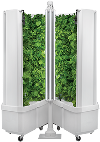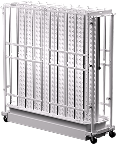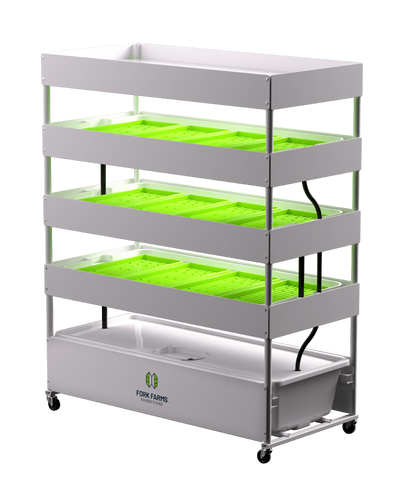Can You Grow Lettuce Indoors? A Guide to Growing Lettuce Indoors With A Hydroponic Garden
Hydroponic farming continues to revolutionize how we grow and consume food. By using nutrient-rich water solutions instead of soil, this innovative approach to food production bypasses many of the concerns and/or obstacles typically associated with traditional agriculture.
The Hydroponics Advantage For Growing Lettuce
Because hydroponic systems are often set up indoors, they’re able to produce fresh fruits, vegetables, and herbs year-round, regardless of the season. Growing plants in a climate-controlled environment rather than the outdoors protects crops from extreme heat, cold, drought, or other adverse weather conditions.
Hydroponic gardening also allows you to grow more food in a smaller space. By controlling nutrient delivery and, again, the plants’ environment, hydroponic systems can optimize growth and productivity, leading to higher crop yields compared to traditional farming methods. This increased efficiency makes hydroponics a great solution for urban areas or regions with limited arable land.
The advantages don’t stop there. From their ability to scale up or down to match production goals, to improving the quality and nutritional value of crops, to reducing the need for chemical pesticides and fertilizers, indoor hydroponic systems are well suited to a growing number of applications, including personal use, in the classroom, within communities, and elsewhere.
Why is Lettuce A Great Choice For Hydroponic Gardens?
Lettuce is a popular choice for indoor hydroponic gardening for several reasons. First, it’s a fast-growing plant, which means that you can enjoy fresh, homegrown greens in just a few weeks; even many of the slower-growing varieties can be harvested within two months.
Another reason why lettuce is ideal for hydroponics is because it’s relatively low-maintenance. Lettuce is a hardy plant that can thrive in a variety of conditions, making it a great option for novice farmers or those who don't have a lot of time to dedicate to their garden. Additionally, lettuce doesn't require a lot of space to grow, so you can easily fit several plants in a compact indoor system.
What’s more, lettuce is a versatile plant that comes in so many varieties. It can be used in countless dishes, including salads, sandwiches, and wraps, making it a great choice for those who enjoy experimenting with different recipes.
And, let’s not forget that lettuce is also highly nutritious. It’s a good source of vitamins A, C, and K, as well as folate and fiber. Growing your own lettuce indoors means you’re getting the freshest and most nutrient-rich greens possible, without having to worry about pesticides or other harmful chemicals that may be used in store-bought produce.
What Are The Best Hydroponic Systems For Growing Lettuce
When it comes to growing lettuce indoors, there are several different types of hydroponic systems that fit the bill.
The Nutrient Film Technique (NFT) system is a popular choice because it is simple to set up and maintain. This system uses a thin film of nutrient solution that flows over the plant’s roots, providing them with the nutrients they need to grow quickly and efficiently.
A Drip Irrigation system is another popular option for cultivating hydroponic lettuce. This setup delivers a controlled flow of water and nutrients to the roots through small tubes or drippers. Considered relatively cost-effective and easy to maintain, Drip Irrigation systems are pretty simple to scale up or down.
The Deep Water Culture (DWC) system is yet another solid choice for growing lettuce indoors. This system involves suspending the plant roots in a nutrient solution, allowing them to absorb the nutrients they need to thrive. In addition, DWC systems provide ample oxygen to the roots, which promotes healthy growth.
Other systems that can be used to grow lettuce hydroponically include Ebb and Flow, which repeatedly floods the roots with a nutrient-rich solution that is then drained back into a reservoir; and Aeroponics, where the plants’ roots are suspended in the air and misted or sprayed with a nutrient solution.
When deciding which technique is best for your program, consider factors like space, budget, scalability, care requirements, and level of experience.
One system that’s highly scalable and doesn’t occupy much space at all–less than 10 square feet, in fact–is the Flex Farm, which is an aeroponic system, creating the optimal conditions for growth. Requiring just two hours of regular maintenance per month, the Flex Farm utilizes innovative vertical farming technology to produce a whopping 25-plus lbs. of fresh food every 28 days! In addition to a self-contained water system, the Flex Farm package includes an energy-efficient LED light tower, submersible pump, Grower Toolkit, and Starter Supplies Box.
What Are The Best Lettuce Varieties For Hydroponics?
The general rule of thumb is that you can grow almost any type of lettuce in a hydroponic garden. That said, some varieties are particularly well-suited to these controlled environments. Following are a handful of the most popular varieties for indoor growing:
- Butterhead (Bibb, Boston, Red/Green Oakleaf)
- Looseleaf (Simpson Elite, Red Sails, Salad Bowl)
- Leaf Lettuce (Black Seeded Simpson)
- Romaine (Little Gem, Paris Island Cos)
Consider your flavor and appearance preferences, too. And don’t be afraid to experiment with some different varieties to see which ones do best in your garden.
Proper Care & Maintenance of Your Hydroponic Lettuce
Growing hydroponic lettuce is simple and low-maintenance once it’s established in your system. The keys to proper care will be ensuring your crops get adequate light, keeping the air temperature stable, and consistently monitoring and adjusting water and nutrient levels.
While lettuce doesn’t require an inordinate amount of light, it does need enough to promote photosynthesis and healthy growth. There will be some variation among different lettuce types, but exposing them to 14-16 hours of moderate light per day should satisfy most varieties. Just be careful not to overdo it, as too much light can cause leaves to become bitter and cause tip burn. At the other extreme, not giving your crops enough light can cause elongation.
When it comes to their water’s pH levels, the sweet spot for most hydroponic lettuce is around 6.0. Some variation up (to 6.5) or down (to 5.5) should be fine, however. You’ll also want to check your nutrient solution regularly for signs of evaporation and replenish it accordingly to prevent any deficiencies.
Speaking of nutrients, your solution should contain healthy amounts of Nitrogen, Potassium, Magnesium and Phosphorus, as well as enough Calcium to prevent tip burn or wilted leaves. It should also include (at least trace amounts of) micronutrients like Iron, Manganese, Zinc, Copper, Molybdenum, Boron, and Nickel to support overall plant health.
And, don’t forget to monitor the temperature and humidity levels to make sure your lettuce is comfortable in its environment. It’s recommended that daytime temperatures be kept between 68-75 degrees F., with nighttime temps a little cooler at 60-65 degrees F. Good ventilation and airflow are critical, too, as they will help ward off indoor pests and prevent the onset of mold or fungal diseases.
Lettuce Get Started
For all the fruits, vegetables, and herbs you can grow hydroponically, lettuce is often considered a top choice because it’s easy to care for and doesn’t take long to reach maturity. Plus, there are numerous varieties to choose from. And while some are better suited for hydroponic systems than others, it shouldn’t be hard to settle on one or more types that suit your culinary and taste preferences.
If you’re ready to start growing your own fresh, healthy lettuce, we encourage you to reach out to one of Fork Farms’ expert team members today. They can provide you with tips and advice, guidance, and support every step of the way, whether you're a first-time farmer or a seasoned agriculturalist.























